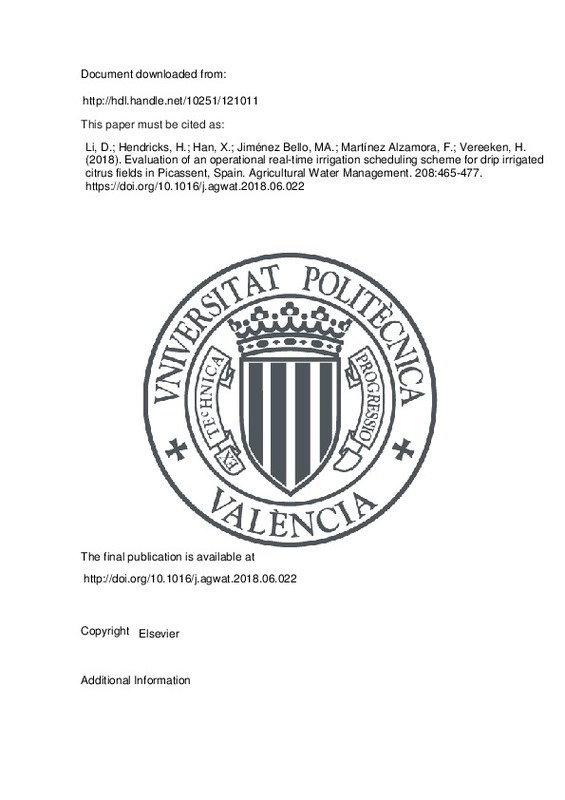JavaScript is disabled for your browser. Some features of this site may not work without it.
Buscar en RiuNet
Listar
Mi cuenta
Estadísticas
Ayuda RiuNet
Admin. UPV
Evaluation of an operational real-time irrigation scheduling scheme for drip irrigated citrus fields in Picassent, Spain
Mostrar el registro sencillo del ítem
Ficheros en el ítem
| dc.contributor.author | Li, Dazhi
|
es_ES |
| dc.contributor.author | Hendricks, Harrie-Jan
|
es_ES |
| dc.contributor.author | Han, X.
|
es_ES |
| dc.contributor.author | Jiménez Bello, Miguel Angel
|
es_ES |
| dc.contributor.author | Martínez Alzamora, Fernando
|
es_ES |
| dc.contributor.author | Vereeken, H.
|
es_ES |
| dc.date.accessioned | 2019-05-23T20:03:51Z | |
| dc.date.available | 2019-05-23T20:03:51Z | |
| dc.date.issued | 2018 | es_ES |
| dc.identifier.issn | 0378-3774 | es_ES |
| dc.identifier.uri | http://hdl.handle.net/10251/121011 | |
| dc.description.abstract | [EN] Irrigated agriculture is very important for securing food production for an increasing population over the next decades. Given scarcity of water resources, optimal irrigation management is needed to reduce water while realizing maximal crop productivity. The new method of integrating soil water content measurements and the Community Land Model (CLM) using sequential data assimilation (DA) is promising to improve the prediction of soil water status and efficiently design irrigation strategies. Soil water content measured by FDR (Frequency Domain Reflectometry) was assimilated into CLM by LETKF (Local Ensemble Transform Kalman Filter) to improve model predictions. Atmospheric input data from GFS (Global Forecast System) were used to force CLM in order to predict short-term soil water contents. The irrigation amount was then calculated on the basis of the difference between predicted and targeted soil water content over the root zone. During the real-time irrigation campaigns in Picassent (Spain) in 2015 and 2016, there were 6 fields irrigated according the data assimilation-optimization approach (CLM-DA), 2 further fields according the FAO (Food and Agriculture Organization) water balance method and also 2 fields traditionally according the farmers preference. The required amount of irrigation water for each citrus field was applied by SCADA (supervisory control and data acquisition system). Compared with the traditionally irrigated fields by farmers, 24% less irrigation water was needed for the CLM-DA scheduled fields averaged over both years from July to September, while the FAO fields were irrigated with 22% less water. Stem water potential data and soil moisture recordings of the CLM-DA scheduled fields did not indicate significant water stress during the irrigation period. The CLM-DA scheduled fields received less irrigation water than traditionally irrigated fields, but the orange production was not significantly suppressed. Overall, our results show that the CLM-DA method is attractive given its water saving potential and automated approach, ease of incorporation of on-line measurements and ensemble based predictions of soil moisture evolution. | es_ES |
| dc.description.sponsorship | The first author of this paper was funded by a stipend from the Government of China (CSC scholarship). The support of the super computing facilities of Forschungszentrum Juelich (JURECA) is gratefully acknowledged. We are also thankful to our colleagues in IVIA and Universitat Politecnica de Valencia for the installation of soil moisture sensors and conducting stem water potential measurements. | es_ES |
| dc.language | Inglés | es_ES |
| dc.publisher | Elsevier | es_ES |
| dc.relation.ispartof | Agricultural Water Management | es_ES |
| dc.rights | Reconocimiento - No comercial - Sin obra derivada (by-nc-nd) | es_ES |
| dc.subject | Irrigation scheduling | es_ES |
| dc.subject | Data assimilation | es_ES |
| dc.subject | Real-time control | es_ES |
| dc.subject | Citrus trees | es_ES |
| dc.subject | Land surface model | es_ES |
| dc.subject | Stem water potential method | es_ES |
| dc.subject.classification | INGENIERIA HIDRAULICA | es_ES |
| dc.title | Evaluation of an operational real-time irrigation scheduling scheme for drip irrigated citrus fields in Picassent, Spain | es_ES |
| dc.type | Artículo | es_ES |
| dc.identifier.doi | 10.1016/j.agwat.2018.06.022 | es_ES |
| dc.rights.accessRights | Abierto | es_ES |
| dc.date.embargoEndDate | 2019-09-30 | es_ES |
| dc.contributor.affiliation | Universitat Politècnica de València. Departamento de Ingeniería Hidráulica y Medio Ambiente - Departament d'Enginyeria Hidràulica i Medi Ambient | es_ES |
| dc.description.bibliographicCitation | Li, D.; Hendricks, H.; Han, X.; Jiménez Bello, MA.; Martínez Alzamora, F.; Vereeken, H. (2018). Evaluation of an operational real-time irrigation scheduling scheme for drip irrigated citrus fields in Picassent, Spain. Agricultural Water Management. 208:465-477. https://doi.org/10.1016/j.agwat.2018.06.022 | es_ES |
| dc.description.accrualMethod | S | es_ES |
| dc.relation.publisherversion | http://doi.org/10.1016/j.agwat.2018.06.022 | es_ES |
| dc.description.upvformatpinicio | 465 | es_ES |
| dc.description.upvformatpfin | 477 | es_ES |
| dc.type.version | info:eu-repo/semantics/publishedVersion | es_ES |
| dc.description.volume | 208 | es_ES |
| dc.relation.pasarela | S\368227 | es_ES |
| dc.contributor.funder | China Scholarship Council |







![[Cerrado]](/themes/UPV/images/candado.png)

